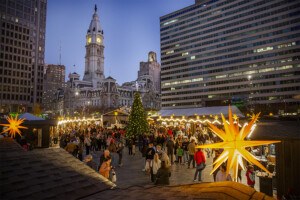Jane Golden’s Mural Arts Program Turns 30
Through this spring, the esteemed Pennsylvania Academy of the Fine Arts is hosting a Mural Arts retrospective, in commemoration of the program’s 30th anniversary. This may be of consternation to more than a few critics who wouldn’t be caught dead pairing “mural” and “fine arts” in the same sentence.
In 1984, when Mural Arts began as an anti-graffiti initiative, no one would have thought to argue there might one day be too many murals. Now, nearly 4,000 murals later, the brainchild of executive director Jane Golden has become a punching bag for the city’s tastemakers.
For the $1.4 million the city shells out yearly, some critics, including Inquirer architecture writer and Mural Arts antagonist Inga Saffron, question the return on investment. Others—many others—offer aesthetic critiques.
Both charges are shortsighted. Sure, there are horrific murals out there. But recently, Mural Arts has begun attracting artists who have vastly increased the scope and quality of the city’s public art. In 2010, Steve Powers painted his sweet “Love Letter” along a 20-block stretch of West Philly. In 2012, the Dutch duo Haas & Hahn blanketed a series of derelict buildings on Germantown Avenue with an ecstatic pastel palette. And this spring, Berlin-based Katharina Grosse will complete a graffiti-inspired installation from North Philly to 30th Street Station.
On the civic side, there are also concrete signs of progress. Mural Arts’ work with the city’s Youth Violence Reduction Partnership has translated into lower-than-average recidivism rates for juvenile offenders. And after Haas & Hahn began painting in North Philly, the city created an economic development plan for the Germantown Avenue business corridor, plus a $3.5 million grant for beautification.
Of course, Mural Arts isn’t going to turn Germantown Avenue into East Passyunk. But since when do we demand avant-garde quality and economic revitalization of our public art? Saying “‘There aren’t 20 new businesses on Germantown Avenue’ is really holding it to much too high a standard,” says Gary Steuer, the city’s former arts czar.
Still, the program’s recent signs of progress suggest Golden is listening to her critics, many of whom have attacked her weakness for quantity over quality. Whatever becomes of Mural Arts in the next 30 years, Golden tells me, she won’t be commissioning “3,000 more murals.”



